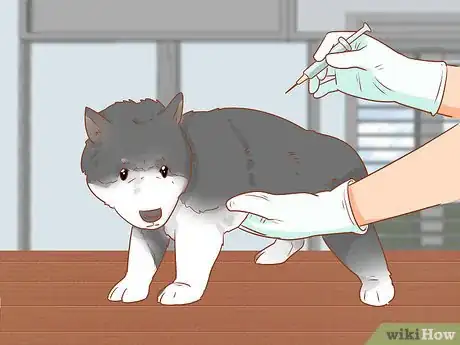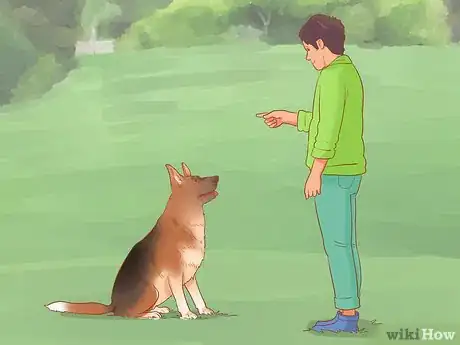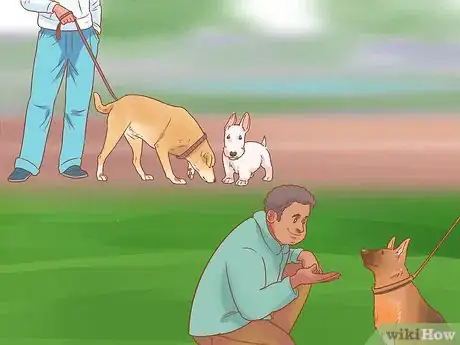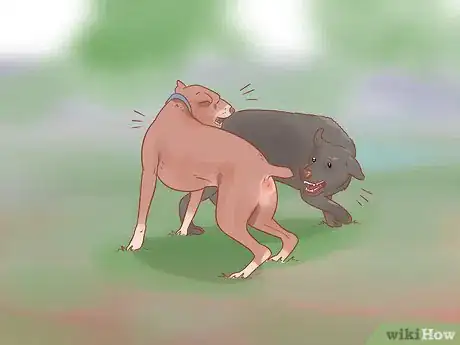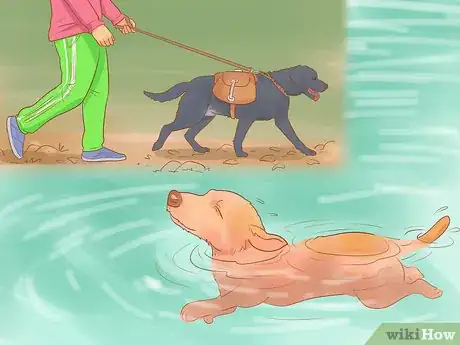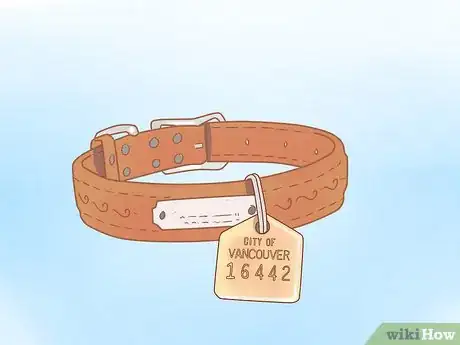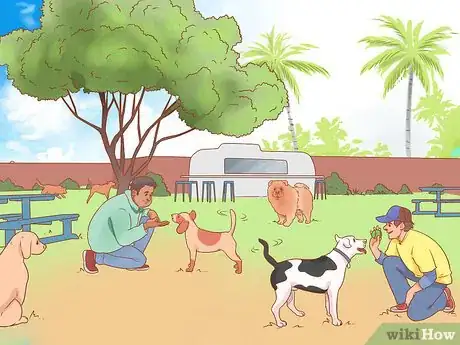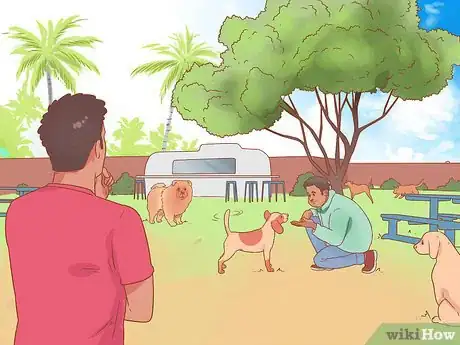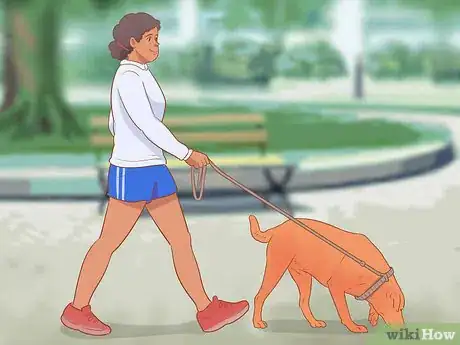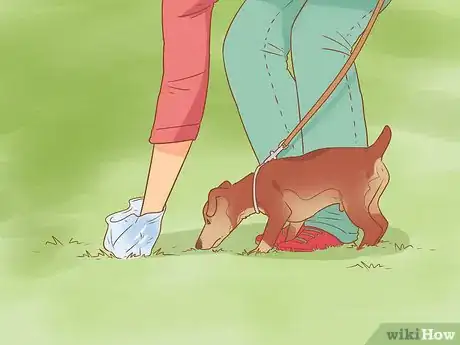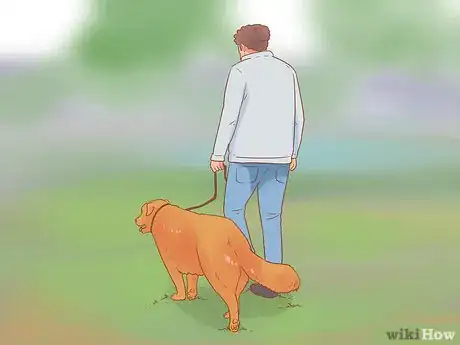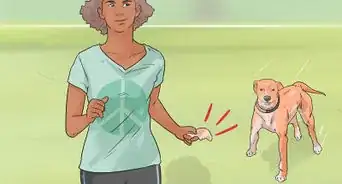This article was co-authored by Melissa Nelson, DVM, PhD. Dr. Nelson is a Veterinarian who specializes in Companion and Large Animal Medicine in Minnesota, where she has over 18 years of experience as a veterinarian in a rural clinic. She received her Doctor of Veterinary Medicine from the University of Minnesota in 1998.
There are 9 references cited in this article, which can be found at the bottom of the page.
wikiHow marks an article as reader-approved once it receives enough positive feedback. In this case, 100% of readers who voted found the article helpful, earning it our reader-approved status.
This article has been viewed 60,173 times.
Dog parks are a great way to socialize your dog, but just like a child at daycare, dogs can sometimes be hesitant to enter a dog park. Let your dog take all the time necessary, and do some advance preparation yourself to make this transition easier. By picking a park with the right conditions, learning about how your dog interacts with other dogs, and knowing what behavioral flags to watch for, you can make your dog’s first visit to the dog park a positive one.
Steps
Preparing in Advance
-
1Complete all vaccinations. Puppies and rescue dogs should finish their full course of vaccinations before they visit a park with other dogs. An unvaccinated dog could catch parvo, kennel cough, hookworms, rabies, or another potentially fatal disease. Keep all of your dog’s vaccinations up to date as recommended by a veterinarian.
- If the dog is very young or was recently ill or malnourished, check with a veterinarian first, even after vaccination. The dog may need some time to build up its immune system.[1]
-
2Train your dog. At minimum, your dog should respond to the "come" command while off the leash. Down, sit, and stay are also useful commands to teach your dog. An untrained dog can be a safety risk to itself and others at the dog park. If you're not sure whether your dog is ready, try practicing commands off-leash in a fenced-in backyard or in your apartment hallway.
- To teach your dog a new command, you will need to mark the behavior with the corresponding word. For example, if you are training your dog to sit, then say “sit” and gently guide your dog’s bottom to the floor. Or, you can also use a treat as a lure to get your dog to sit by holding it above their head. Just remember to say “sit” as you do this.[2]
- Be sure to provide plenty of positive reinforcement when training your dog. For example, if you dog responds to your command to “sit,” then reward him with some praise. You can even give your dog a treat now and then to help motivate him.
- If you know your dog has behavioral problems, especially aggression, consider attending puppy classes or hiring a professional trainer. Don't visit the park until you are confident you can prevent the bad behavior and stop it promptly if it happens.
- A trainer can also help teach a puppy appropriate play/bow behavior. These are the body language cues used by dogs when playing with each other.[3]
Advertisement -
3Learn to identify your dog's preferences. While walking your dog, pay attention to how it reacts to other dogs and to people. Some dogs are anxious or hostile around men, overly friendly people, or large dogs. If you know how your dog tends to react, you can respond quickly to calm it down at the park.
- Your dog can start to learn socialization skills outside of the park. Try taking it to areas with lots of foot traffic, or better yet, arrange play dates with another dog.
- Don’t put your dog in a position where it has a chance to fail until you are confident of its behavior. Work on socialization skills in controlled environments until both you and your dog are confident in its good behavior.[4]
-
4Learn how to stop a dog fight. There is always a chance your dog will get into a fight at a dog park. Before you go, learn how to break up a fight effectively. Never use your bare hands. Always place something between the two dogs, such as a piece of cardboard or a jacket. You can also break up a fight by making loud noises, like blowing a small air horn or clapping your hands, or spraying water or a citronella spray in the middle of the skirmish.
- Don’t yell at your dog, try to pull it away by the collar, or get in the middle of the fight. Doing so will only add to the chaos.[5]
-
5Give your dog enough exercise. Make sure you meet your dog's exercise needs, based on its age and breed. If your dog is cooped up longer than it should be, it might get over excited when let off the leash at the dog park.
- Dogs are like people in that they get out of shape and can suffer needless injury by being a “weekend warrior” and overdoing it when they are not in shape. Be especially wary in warmer weather, which can cause heat stroke quickly, especially for dogs with chronic illnesses, heart issues, and for brachycephalic breeds (those with pushed in faces).[6]
-
6Check for parasites. Look for fleas and ticks regularly to avoid spreading them to other dogs at the park. Consider using preventative medicine for these parasites, since your dog will probably be exposed to them at the park.[7]
- If your dog has lost energy or appetite, visit a vet to check for heartworm as well. Your vet can also recommend medication to help prevent heartworm, which is transmitted by mosquitoes.[8]
-
7Obtain an off-leash permit tag. Some dog parks will require your dog to have an off-leash permit in order to play in the park. Check with any dog parks you’re considering visiting to find out what their regulations are regarding this and how to go about getting one.
- An off-leash permit shows authorities (and other dog owners) that your dog is up-to-date with vaccinations and that you are a responsible dog owner who is concerned with the safety of your dog as well as the other people and dogs at the park.[9]
Picking the Right Time and Place
-
1Choose a park with the right conditions for your dog. There are lots of considerations when choosing a dog park. Many of these considerations may depend on the size of your dog, its socialization skills, its attitude toward other dogs, and your own personal preferences. Some things to look for include:
- Look for a park that separates dogs by size. For example, some parks may have a separate enclosure for dogs under 20 pounds or by age (puppies and elderly dogs).
- If you're not 100% confident in your dog's training, choose a park with containment fencing or plan to keep the dog on a leash at all times. Look for fences that have separate entrance and exit gates and don’t contain any 90 degree angles so that your dog cannot be cornered by another dog.
- Also, look for parks that have plenty of open space for your dog to run, shade, and water.
- Try to avoid parks next to busy roads unless your dog knows to stay away, even if the gate is normally closed.
- If visiting a park in the evening, make sure it is well lit.
- Large parks with underbrush may contain wild animals. Be aware of the risk of skunks, raccoons, or other animals native to your area.
-
2Observe the other dogs before entering. Whether or not you and your dog have a positive experience at the dog park depends, in part, on the other dogs there. Before you go in, take a few minutes to watch the other dogs. If they seem too aggressive or excited, it may be better to bring your dog back at a different time or choose a different park.[10]
- If you have a puppy or tiny dog, look for other dogs the same age and size. If large or aggressive dogs are dominating the park, this may not be a comfortable place to visit.
-
3Pick a time when the park is mostly empty. Dog parks are often packed on evenings and weekends. If you can, visit during a weekday afternoon for your first trip. This will give your dog the chance to explore in a calmer environment.
- Try to keep your first couple visits to only 20 or 30 minutes as well.[11]
-
4Walk around the perimeter. Let your dog become familiar with the area by walking it on the sidewalk just outside the park. Let it stop and sniff the edges of the park as you walk. The dog is ready to go in when he looks relaxed. A stiff neck, bulging eyes, or freezing in place are all signs of anxiety.
- Doing this is also a great way to start introducing your dog to the other dogs at the park without the anxiety of not being able to get away from them.[12]
Entering the Park
-
1Know the leash rules. Check for signs or watch what other dog owners are doing regarding leash rules. Many large dog parks have a double-gate system, where you remove your dog's leash when you're between the gates. Be careful entering the park with a leashed dog, as the leash can cause your dog to act defensive or aggressive toward the unleashed dogs.
- In less dog-friendly cities, "dog parks" are more like ordinary parks where dogs are allowed. Some of these parks require you to keep your dog on leash.
- If your dog is not well-trained, it's best to avoid off-leash parks completely.
-
2Ease your dog into playing off-leash. If your dog isn’t used to being off-leash, you can ease it into this by trying a couple different methods:
- Take off your dog’s leash for a while after entering the park—about 20 or 30 minutes—and then put it back on. Gradually increase the time you let your dog off-leash until you are comfortable doing so all the time.
- You can also switch your dog’s short leash for a longer one when you get to the dog park. Leave the longer leash on your dog while it plays. This will allow you to more easily catch your dog if it isn’t responding to your commands.[13]
-
3Expect a rush of dogs. A crowd of dogs often rushes up to meet the newcomer. Don't be startled or anxious. Keep an eye on the dogs, but let them do their thing while you meet their owners.
- If possible, try to introduce your dog to other dogs at the park gradually. Take your dog to any secluded areas of the park at first where the number of dogs is limited.[14]
-
4Watch your surroundings. Stay alert and know where your dog is at all times. You will both be making new friends, but don't get too distracted. It is your responsibility as a dog owner to ensure your dog is behaving itself and to make sure another dog isn’t causing your dog harm.
- If you also have small children, bringing them to the dog park might not be a good idea. It can be tough to watch both your dog and a young child at the same time.
- Be especially vigilant of small dogs around big dogs. Whether your dog is the big or small one, don’t allow big dogs to threaten or play too rough with small dogs.
- If your dog is too frightened, excited, or aggressive toward other dogs, leave the park for a bit. Doing so will ensure you prevent any problems before they begin and give your dog a chance to calm down.
- Don’t be ashamed to muzzle your dog the first few times you visit the park if you’re not sure how it will react to other dogs.
- Know how to read dog body postures and social behavior before going to the dog park. Educate yourself so that you can recognize the difference between stress, fear, play, and aggressive behavior.[15]
-
5Pack the right treats and toys. It's a good idea to bring something to calm your dog down if it gets nervous, or to attract its attention. That said, you don't want to be responsible for the Great Bacon Stampede when three dozen dogs notice what you're holding. Pick a basic treat that your dog enjoys, but nothing with too strong a smell. And of course, a toy to play with is always welcome.
- Don’t, however, bring a toy or treat you know your dog won’t be willing to share, as this could cause a fight.[16]
-
6Look for playful actions from your dog. The whole point of taking your dog to a dog park is for it to have a good time with other dogs. You can determine if it is having fun by watching is body movements and actions. The following body language is a good indication your dog is having a good time:
- Your dog’s movements are bouncy and exaggerated. It may also wiggle its body around with excitement.
- Your dog will engage in back and forth play with other dogs. This means that the dogs will switch roles while they are playing. For example, your dog may start off chasing another dog, but eventually the roles will switch and the other dog will be chasing yours.
- Your dog’s mouth will be open and relaxed.
- Your dog will play-bow around the other dogs. Play-bowing is when a dog lowers the front half of its body, stretching out its front legs and raising its hind quarters in the air.
- Your dog might also show excitement with twisted leaps or pawing at the air.
-
7Pick up after your dog. This should go without saying, but pick up after your dog promptly. Many dog parks have a box stocked with plastic bags, but always bring your own baggie or scooper just in case.[17]
-
8Be friendly with other dog owners. Let them know your dog is new to the dog park and ask them to respect your dog's boundaries. The other owners can be very helpful when it comes to socializing your dog.
- For example, say "My dog is fearful when other dogs race over to him. Can you help me make sure we keep a safe boundary between our dogs?"[18]
-
9Leave the park at signs of conflict. If your dog starts harassing other dogs, or if the other dogs harass yours, leave the park right away. This prevents the conflict from escalating and, if your dog was the culprit, sends a message that the behavior is not allowed.
- It is also a good idea to have the number for animal control handy in case there is an owner who will not remove its aggressive dog from the park.[19]
Warnings
- Dogs tend to behave differently when in a "pack." Be extra cautious when bringing multiple dogs to the park, or when your dog has made close friends with the regulars.⧼thumbs_response⧽
- Do not visit the dog park if your dog is over five months old and not neutered, especially if the dog is in heat. The scent can trigger bad behavior in other dogs, even if yours is well trained.⧼thumbs_response⧽
- If your dog tends to eat feces, this habit needs to be corrected before it visits the park. Even when vaccinated, this exposes the dog to disease and parasites.⧼thumbs_response⧽
References
- ↑ https://www.animalhumanesociety.org/training/you-go-dog-park
- ↑ http://www.akc.org/content/dog-training/articles/teach-your-puppy-these-5-basic-commands/#sit
- ↑ https://www.animalhumanesociety.org/training/you-go-dog-park
- ↑ https://www.animalhumanesociety.org/training/you-go-dog-park
- ↑ http://www.animalbehaviorassociates.com/dog_park_etiquette.htm
- ↑ https://www.cesarsway.com/dog-care/dog-park/cesars-dog-park-tips
- ↑ http://www.petsandparasites.org/dog-owners/overview
- ↑ http://www.petsandparasites.org/dog-owners/heartworms/
- ↑ https://www.animalhumanesociety.org/training/you-go-dog-park
- ↑ http://www.animalbehaviorassociates.com/dog_park_etiquette.htm
- ↑ http://dogtime.com/dog-health/general/5014-introduce-puppy-dog-parks-dunbar-faq
- ↑ http://www.animalbehaviorassociates.com/dog_park_etiquette.htm
- ↑ http://dogtime.com/dog-health/general/5014-introduce-puppy-dog-parks-dunbar-faq
- ↑ http://www.animalbehaviorassociates.com/dog_park_etiquette.htm
- ↑ http://www.animalbehaviorassociates.com/dog_park_etiquette.htm
- ↑ http://www.animalbehaviorassociates.com/dog_park_etiquette.htm
- ↑ https://www.animalhumanesociety.org/training/you-go-dog-park
- ↑ https://drsophiayin.com/blog/entry/dog-park-etiquette-rules/
- ↑ http://www.animalbehaviorassociates.com/dog_park_etiquette.htm
